This website uses cookies so that we can provide you with the best user experience possible. Cookie information is stored in your browser and performs functions such as recognising you when you return to our website and helping our team to understand which sections of the website you find most interesting and useful.
Sake special: Sake trends and a study of the French market
In the final instalment of a three-part series, the Kyoto Municipal Institute of Industrial Technology and Culture (KMIITC) shares the latest sake export data and reveals the results of its survey of French sake consumers.
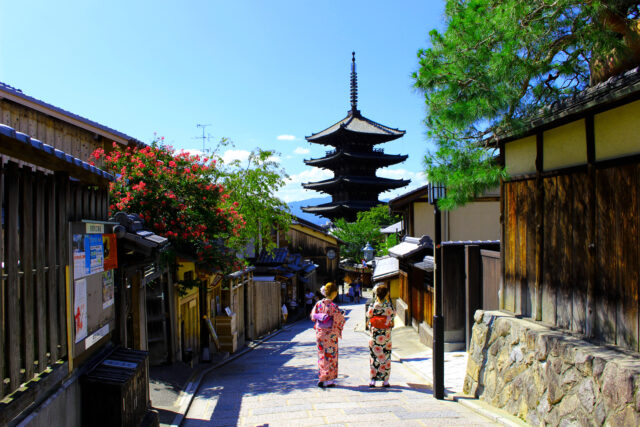
From January to December 2020, sake exports reached a record high for the eleventh consecutive year. Shipments rose by 3.1% to reach 24.1 billion yen, despite being significantly affected by Covid-19.
Sake now accounts for around 34% of the total value of Japanese alcohol exports (71.1 billion yen) and is second only to Japanese whisky, which achieved exports worth 27.1 billion yen last year.
According to figures which date back to 1988, sake’s rise to prominence is relatively recent. It was only in 2013 that its export value exceeded 10 billion yen. Just five years later, this value had doubled to more than 20 billion yen.
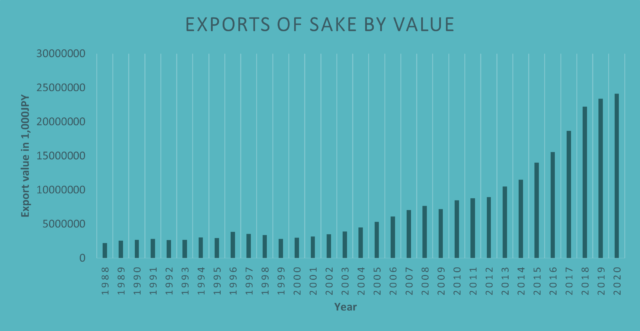 Sake is now exported to 61 countries and territories. 69% of sake is sent to Asia, 22.8% to North America, 5.2% to Europe (including Russia), 2.3% to Oceania, 0.3% to the Middle East and the remaining 0.4% to other smaller markets.
Sake is now exported to 61 countries and territories. 69% of sake is sent to Asia, 22.8% to North America, 5.2% to Europe (including Russia), 2.3% to Oceania, 0.3% to the Middle East and the remaining 0.4% to other smaller markets.
While a wide variety of people from around the world have helped to increase the export of sake, a particularly important role has been played by the proliferation of sake education and competitions, as well as the combined efforts to develop sales channels, promote sake and food pairings, and establish GIs.
The Sake Service Institute (SSI), Japan’s leading industry body for sake, has helped pioneer sake education abroad, with over 5,000 international sake qualifications given to people from more than 30 countries.
London-based Sake Sommelier Academy (SSA) has also developed the Sake Sommelier accreditation, while the Wine and Spirit Education Trust (WSET) developed its sake education programme in August 2014.
Sake competitions in the UK and France, such as the International Wine Challenge and Kura Master, have helped to increase recognition of sake, both among consumers but also sommeliers, wine specialists and restaurateurs.
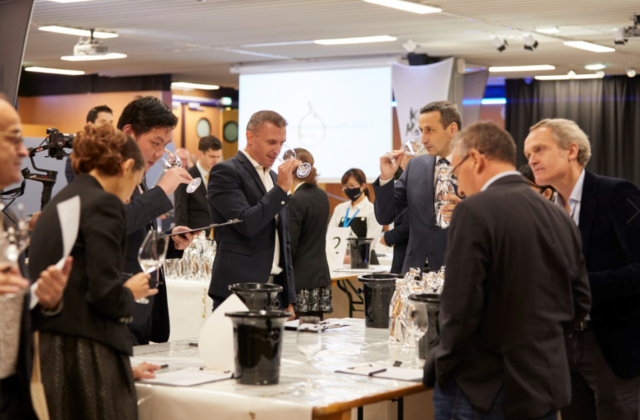
In addition, the adoption of Japanese food as a UNESCO World Intangible Cultural Heritage Site in 2013 has led to a rapid rise in the number of Japanese restaurants worldwide. Figures have risen from around 24,000 in 2006 to some 156,000 in 2019. This has led to a corresponding increase in the number of outlets stocking sake.
The Japanese government has vowed to increase the value of sake exports to 60 billion yen by 2025. Support for the development of sales channels and other sake-related activities, therefore, is likely to increase in the years ahead.
The growth of sake exports by value contrasts with a decline in domestic sake sales. Volumes of Japanese sake consumed in the domestic market have declined from a peak of more than 200 million (12x720ml) cases in 1973 to a quarter of that amount today.
According to preliminary figures released by the Japan Sake and Shochu Makers Association last month, taxable transfers of sake (sales excluding exports) in 2020 was 417,029.2 kilolitres – down 10.7% on 2019 – the equivalent of around 48.3 million (12x720ml) cases.
While exports by value have increased, the volume of sake that is exported remains low. Last year it amounted to only 2.5m (12x720ml) cases, equating to around 5% of total sake production. This means it is still far from enough to make up for the decrease in domestic production.
There are estimated to be a total of 76.5 million alcohol drinkers in Japan (January to April 2020), however of these people, only 15% bought sake at least once in the off-trade. This compares to the proportion that bought beer (around 25%), RTD products (39%) and wine (18%).
720mL①.JPG_2-237x640.jpg)
Within this context, the KMIITC has been cultivating different yeast strains. These play an important role in the taste and aroma of sake, and it is hoped that new developments will lead to increasing demand for sake both in Japan and abroad.
As previously reported, yeast is responsible for 60% of the flavours in sake, compared to around 50% for beer and 20% for wine.
The KMIITC has been supplying yeast to sake breweries in Kyoto since 1962. Kyoto’s Fushimi district, which boasts 22 breweries which account for 99% of total production in the Kyoto region, has increased its domestic market share from 8% in 1982 to around 17% in 2019, narrowing the gap between it and the Nada region in the Hyogo prefecture, which is on top with a 21% market share.
Kyoto yeast development
The five most-recently developed yeasts by the KMIITC are known as Kyoto yeasts, and each have their own unique characteristics. The yeasts were mainly developed to impart desirable fruity/floral aromas, known as ginjo.
The yeasts include:
- Kyo-no-koto: produces high levels of ethyl caproate and creates green-apple aromas.
- Kyo-no-hana: produces high levels of isoamyl acetate and creates a banana-like scent.
- Kyo-no-saku: produces high levels of malic acid and creates a fresh taste in sake designed to be drunk chilled.
- Kyo-no-haku: produces high levels of succinic acid and imparts a rich flavour when heated.
- Kyo-no-koi: contains high levels of malic acid and ethyl caproate, giving the sake a refreshing sweet and sour taste.
French market focus
The KMIITC, in collaboration with sake breweries, has developed a product specifically designed for the French market. As the largest wine market in Europe and the sixth largest wine consuming nation per capita, France has been signalled out as a key country for sake producers. Increasing sake consumption in wine-consuming countries is a top overseas priority and export strategy.
Efforts appear to be paying off. In 2020, France was the top market for sake by export value in Europe. With France being a top tourist destination, the sake industry hopes gaining exposure in the French market will increase sake’s global reach.
Sake consumer survey
As part of its focus on the French market, the KMIITC conducted a survey. Centring on sake consumers in the French capital, Paris, the study aimed to understand the image of sake and level of consumer recognition, what aroma and taste adjectives French drinkers use when consuming sake, and also how they respond to the packaging.
The survey, which is yet to be completed, consists of two parts: an in-depth interview and a quantitative survey. As the survey part is still underway, this piece will focus on the results of the interview section.
What surprised the KMIITC the most when analysing the data was the large gap between the number of sake consumers and the small number of sake brands they recognised.
Japan’s leading brand Dassai has been targeting the French market for many years, while contemporary Japanese sake brewer Wakaze opened a site in Paris in the summer of 2019. This, together with the Kura Master competition, which is held in Paris, has given sake a foothold in France.
The KMIITC, therefore, expected to see relatively high levels of brand recognition and sake drinking experience, however this was not the case.
Of the 1,241 people surveyed, 81% consumed alcohol. Of these, 10.9% were city-dwelling sake drinkers aged between 25 and 54. This is high compared to the fact that only 15% of alcohol drinkers in Japan professed to consuming sake during the period between January and April 2020.
However, when asked to write down brand names that they knew, Hakutsuru was the only one mentioned by a total of 12 people. The KMIITC acknowledged that it can be difficult to recall brand names in such tests. It cited a similar study of wine brand awareness in Japan. Santa Helena Alpaca, a brand name of a wine made by Chilean group VSPT, was named by only half of those surveyed, despite being the top imported wine label with a 95% distribution rate in 2019.
The KMIITC concluded that it would be difficult for non-Japanese speakers to recall a brand name, particularly as sake labels often contain a kanji character and have no letters from the Latin alphabet.
The institute later contacted eight people living in Paris with a certain level of sake-drinking experience. Each person was interviewed in-depth about their sake knowledge. The first key finding was that almost all of those taking part believed sake was a high-alcohol drink like a spirit, a common misconception. According to Japanese sake law, sake must have an ABV below 22%. This, the law makers state, is the highest level of alcohol you can achieve in a brewed or fermented beverage.
Sake brewers use special yeast strains that can continue to ferment at around 20% ABV, whereas most other strains would struggle to remain active beyond 15%-16%.
The KMIITC believes that this misconception is the result of people drinking Chinese spirits, which are often served in overseas Chinese restaurants and mislabelled as ‘sake’.
Indeed, Hong Kong and China are currently the main export markets for sake, account for up to 50% of the total value shipped. There is no evidence of spirits being labelled as sake in either market.
The KMIITC noted that people’s impressions of sake completely changed after drinking the real thing in a Japanese restaurant, or drinking sake on a visit to Japan.
One of the Parisians that was interviewed said sake is “a drink that tastes different from what you imagine”.
The interviewees were then asked to sample three different kinds of sake in a blind tasting and were asked how they would describe the aroma and flavour. The KMIITC said the reason it asked this question is that often descriptors used by professionals in the wine industry, for example, are different to those used by the end consumer. It is therefore important to identify adjectives for sake that align with the local market.
The three types of sake tasted were each made with a different Kyoto sake yeast. The first was produced using kyo-no-koi (refreshing, sweet, sour taste); the second was made with kyo-no-hana (banana-like aroma); and the third was produced using a blend of sakes made with kyo-no-koi and kyo-no-hana.
The participants all identified that the sakes had different aromas and flavours. Unlike wine, sake does not have a wide variety of flavours and the researchers found it interesting to discover how people from a wine-loving nation assessed the samples.
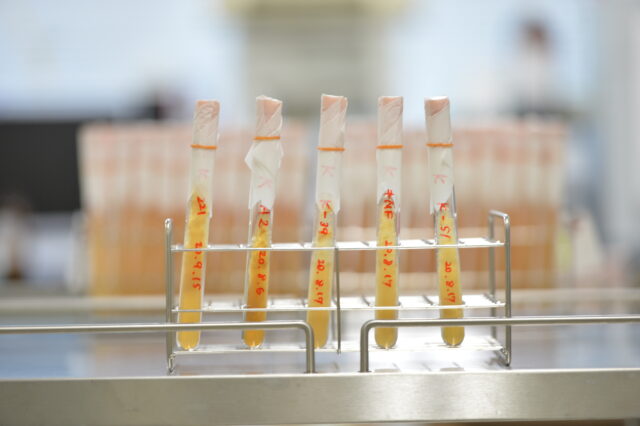
The first sample was evaluated as having exotic floral, lychee, jasmine and lily of the valley aromas, with a rounded mouthfeel and a floral notes on the palate. Meanwhile the second sample was judged to have balanced levels of sweetness and acidity, with flavours of prune, lychee and smoke. The final blended sake was found to be the one with the most complex flavours. The tasters likened its aromas to the grape variety Gewürztraminer and said it had flavours of lemon on the palate.
From the list of aromas and flavours provided, the KMIITC identified 48 that can be empirically linked to the raw materials and production process. After a further quantitative survey, the institute narrowed the terms down to 24.
The identification of official consumer-friendly terms to describe sake has been deemed a “very significant step” for the industry.
Finally, the interviewees were asked for their opinions on traditional sake packaging, as well as that developed by KMIITC for blended sakes. The institute said it resulted in some “very important insights”.
It was revealed that the traditional packaging gave the consumers “a sense of security”. While the more modern branding developed by KMIITC was praised for evoking a sense of luxury, consumers said they found it difficult to determine whether the product inside was actually sake.
Those surveyed also responded positively to the use of the word ‘assemblage’ for blended sake, as well as the inclusion of the specific yeast strains on the label. However, in some cases, they said having the yeast strain number “did not add any value”.
Those surveyed also had an “overwhelmingly negative” reaction to the use of screwcaps, perhaps a reflection of France’s reservation towards the closure type compared to markets such as Australia and New Zealand. Those surveyed by the KMIITC said screwcaps made them think of entry-level drinks, an “important finding” since packaging is an issue not only for Kyoto sake but for the category as a whole.
With only eight people surveyed, each interview lasting for just over an hour, the KMIITC was able to obtain “a great number of findings after the first stage of the survey”. The most important finding was that participants were “very interested” by the fact that clear and colourless sake has a complex aroma/flavour profile, with many similarities to those found in wine. The fact that yeast contributes to such a large percentage of the final flavours found in sake gives the the KMIITC confidence that they will be able to develop more yeast strains that will create desirable flavours.
A total of 8.29 million tourists stayed in Kyoto city in 2019. While the percentage of European visitors to Japan was just 6.2%, the percentage of these travellers that visited Kyoto city was higher at 17.8%. In light of these figures, the KMIITC believes it is “extremely important to provide European visitors, especially those from France, with the opportunity to experience real sake and to have a positive image of sake before returning home”. The institute will continue to develop different sake yeasts which underpin the appeal of sake and support the creation of demand for sake both in Japan and abroad.
Assemblage: blended sake
Blended or assemblage sakes have been gaining attention in recent years. There have been two main sake trends: the first was the era of mass consumption of entry level sake, known as ‘futsushu’. Made by the major sake produces, this futsushu sake was produced on consignment by local breweries and was bought by the big sake companies and blended in-house.
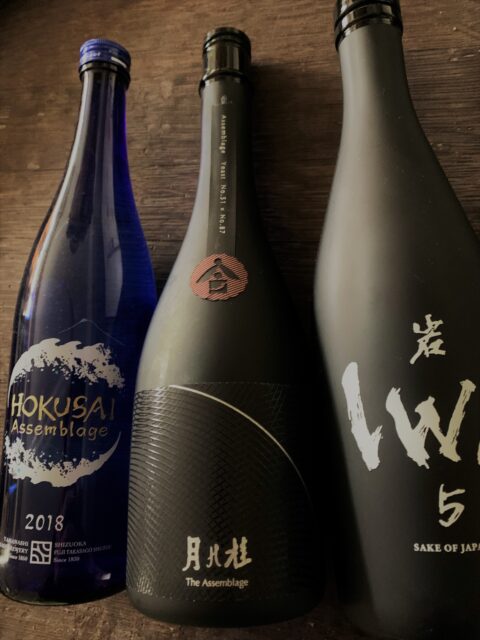
At that time, although the sake was a blend, both the brand name and the name of the brewery that produced the sake for the big sake companies were not mentioned. This process shares similarities to that used for bulk wine. Such products often have generic labelling which does not reference the grape variety used, vintage or specific region of production.
In contrast, in 1990, eight premium categories such as Junmai-Daiginjo and Junmai were created to determine the rice polish ratio and identify whether or not distilled alcohol had been added to the finished sake. As these categories were classified according to the rice polish ratio, blending across sake categories was rarely carried out, even within the same company. There were no examples of sakes from different breweries being blended together.
For example, Junmai Daiginjo sakes are priced at around 5,000 yen while Junmai sakes cost 1,000 yen in Japan. Blending sakes from different categories would mean that the category needed changing depending on the blend ratio. The price would also change.
However, since the launch of Hokusai Assemblage in 2018, a blend of sakes from two breweries in Shizuoka and Yamanashi prefectures that use water from the Mount Fuji including aged sake, the blended sake category began to emerge. These blended expressions are made solely to achieve a “good final taste” and are not restricted by category requirements for the eight premium sake segments.
The KMIITC’s Assemblage Sake, which was given to the panel of tasters and specifically created for the French market, was designed and blended according to the institute’s data and the results of sensory tests.

